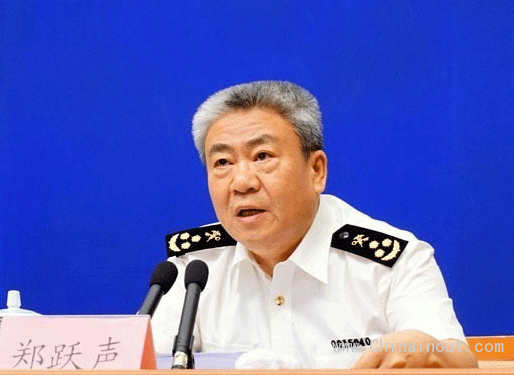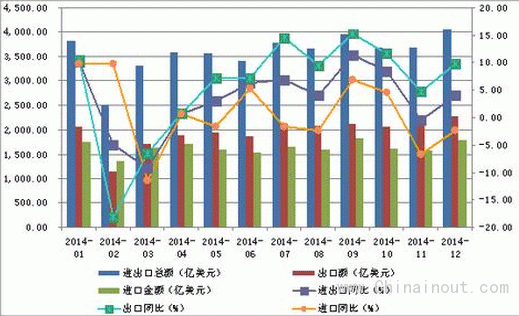
近日,海關(guān)信息網(wǎng)(www.haiguan.info)發(fā)布《2014年我國經(jīng)濟(jì)形勢(shì)綜述及進(jìn)出口貿(mào)易形勢(shì)分析報(bào)告》(以下簡(jiǎn)稱年度報(bào)告),。
報(bào)告認(rèn)為:2015年全球經(jīng)濟(jì)延續(xù)弱勢(shì)復(fù)蘇態(tài)勢(shì),,面臨格局失衡、地緣政治等風(fēng)險(xiǎn),,國內(nèi)經(jīng)濟(jì)增速放緩的同時(shí)結(jié)構(gòu)調(diào)整加快,。進(jìn)出口貿(mào)易或?qū)⒂瓉碚呙芗诤托略鲩L(zhǎng)點(diǎn)培育期。預(yù)計(jì)2015年進(jìn)出口額27.5萬億元人民幣,,增長(zhǎng)約3.9%,;其中,進(jìn)口12.2萬億元人民幣,,增長(zhǎng)約1.3%,,出口15.3萬億元人民幣,增長(zhǎng)約6.1%,。
2014年我國經(jīng)濟(jì)增速放緩,,逐步進(jìn)入“新常態(tài)”運(yùn)行軌道,并呈現(xiàn)以下特點(diǎn):

第二,,2014年我國進(jìn)出口貨運(yùn)量總體保持增長(zhǎng)態(tài)勢(shì),貨運(yùn)量與貿(mào)易額走勢(shì)基本一致,。
第三,,區(qū)域布局進(jìn)一步優(yōu)化:東部地區(qū)外貿(mào)增速放緩,比重持續(xù)回落,;中西部地區(qū)外貿(mào)依然保持高速增長(zhǎng),發(fā)展后勁十足,,或?qū)⒊晌磥砦覈赓Q(mào)新的增長(zhǎng)點(diǎn),。
第四,一般貿(mào)易比重繼續(xù)提高,,外貿(mào)結(jié)構(gòu)調(diào)整成效初步顯現(xiàn),;但一般貿(mào)易項(xiàng)下進(jìn)口微幅萎縮,凸顯內(nèi)需疲軟,。
第五,,從商品分析,機(jī)電進(jìn)出口增,,高新技術(shù)微降,,勞動(dòng)密集型商品出口持穩(wěn),“兩高一資”商品出口快速增長(zhǎng),,大宗商品進(jìn)口量增價(jià)跌,,涉及民生的農(nóng)產(chǎn)品進(jìn)口快速增長(zhǎng)。
此外,,報(bào)告還對(duì)2015年我國進(jìn)出口貿(mào)易的影響因素進(jìn)行深度分析及進(jìn)出口走勢(shì)預(yù)判,。
隨著我國經(jīng)濟(jì)增長(zhǎng)進(jìn)入“新常態(tài)”,2015年我國外貿(mào)將繼續(xù)保持個(gè)位數(shù)增長(zhǎng),。出口方面,,雖然全球經(jīng)濟(jì)整體仍呈現(xiàn)弱勢(shì)復(fù)蘇態(tài)勢(shì),但是“一帶一路”戰(zhàn)略的推進(jìn)將為我國出口提供支撐,,預(yù)計(jì)年內(nèi)出口將繼續(xù)保持平穩(wěn)增長(zhǎng),;進(jìn)口方面,仍面臨國內(nèi)需求偏弱及國際大宗商品價(jià)格下跌的雙重壓力,,但是隨著包括中西部鐵路,、水利工程等基礎(chǔ)建設(shè)項(xiàng)目的相繼啟動(dòng),2015年進(jìn)口增速將有所回升,。預(yù)計(jì): 2015年我國進(jìn)出口額274563億元人民幣,,增長(zhǎng)約3.9%,;其中,進(jìn)口121937億元人民幣,,增長(zhǎng)約1.3%,,出口152626億元人民幣,增長(zhǎng)約6.1%,。(中國進(jìn)出口網(wǎng))
Recently, the Customs Information Network (www.haiguan.info) issued the "2014 China's economic situation and the import and export trade situation analysis summary report" (hereinafter referred to as the Annual Report).
The Report says, in 2015 the global economic will continue the weak recovery trend, facing structure imbalance and geopolitical risks, at the same time of the domestic economic slowdown, structural adjustment is accelerating. import and export trade may usher vigorous policies and new growth point incubation period. It’s estimated that in 2015 import and export volume will reach 27.5 trillion yuan, an increase of approximately 3.9%; of which, imports 12.2 trillion yuan, an increase of about 1.3%, exports 15.3 trillion yuan, an increase of approximately 6.1%.
China's economic growth slowed in 2014, and China’s economy is gradually into the "new normal" orbit, and showed the following characteristics:
First, the 2014 foreign trade growth fell down, weak demand inhibited import growth, and the export leading indicators fell for three consecutive months, export growth was weak.
Second, the 2014 overall import and export goods maintained growth momentum, cargo and trade movements basically stayed the same.
Third, he regional distribution further optimized: the growth of foreign trade in the eastern areas declined; the growth of foreign trade in the Midwest areas remained rapid, the development potential is great, which may become the new growth point of China's foreign trade.
Fourth, the proportion of general trade continued to increase, the structural adjustment of the foreign trade began to come into effect; but the imports of the general trade shrink slightly, highlighting weak domestic demand.
Fifth, in terms of commodity, the imports and exports of electromechanical products grew, high-tech went down, labor-intensive exports stayed steady, the exports of energy-consuming, highly-polluting and resource product increased fast, commodities imports volume increased but values decreased, imports of agricultural products grew fast.
In addition, the report also analyzes the factors affecting China's foreign trade in 2015 and predicts the import and export trends. The report notes that, among the favorable factors include the following three aspects.
As China's economic growth goes into the "new normal", in 2015 China's foreign trade will continue to maintain single-digit growth. In Exports, although the global economy as a whole is still showing weak recovery trend, but the promotion of “one belt one road” strategy will give support to China's exports, exports are expected to continue to maintain steady growth during the year; in imports, dual pressure still exit, the domestic demand is still weak and international commodity prices fall down, but with the Midwest railway, water conservancy project and other infrastructure projects to start, in 2015 imports speed will be picked up. It’s estimated that in 2015 import and export volume will reach 27.5 trillion yuan, an increase of approximately 3.9%; of which, imports 12.2 trillion yuan, an increase of about 1.3%, exports 15.3 trillion yuan, an increase of approximately 6.1%.











